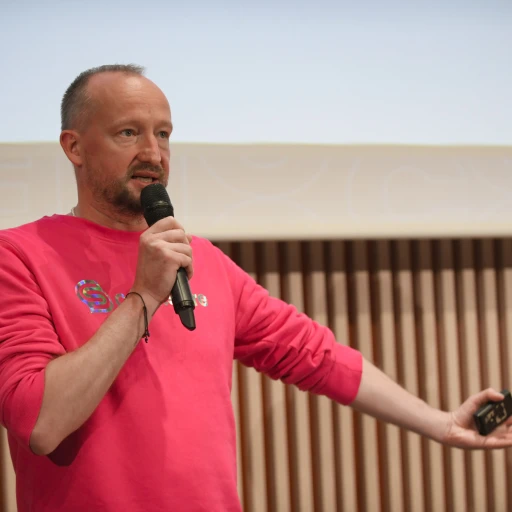
Understanding the importance of logos in modern software
Why Visual Identity Matters in Software Today
In the fast-moving world of software, a strong visual identity is more than just a nice-to-have. Logos are a key part of how users recognize and trust software projects, especially in the open source space. When you see the k3s logo, for example, you instantly connect it with lightweight Kubernetes, single binary deployments, and a focus on simplicity. This instant recognition helps users and developers feel confident about the source and quality of the software they are using.
For projects like k3s, which is a popular lightweight Kubernetes distribution, the logo is not just a decorative image. It signals the project’s values—like being production ready, secure by default, and optimized for containers with a low memory footprint. The k3s logo, available in high quality png and svg formats, is often used in marketing materials, documentation, and even inside container images to reinforce the project’s identity.
- Trust and authenticity: Using the original png or svg logo helps users identify the official project, avoiding confusion with unofficial forks or outdated versions.
- Consistency: A recognizable logo ensures consistency across different platforms, from package managers to server dashboards.
- Community growth: A clear visual identity encourages more developers to contribute, knowing they are part of a reputable and trusted project.
As software becomes more modular and distributed—think containers, microservices, and cloud-native applications—the need for clear, high quality logos grows. Whether you are downloading the latest k3s png icon for your own project or integrating it into a network policy dashboard, the logo serves as a visual anchor for users navigating a complex ecosystem.
For those interested in how branding and visual identity are evolving in the software industry, you might find this article on innovative strategies for blog article management in web studios by 2025 insightful. It explores how clear branding and content organization are shaping the future of software communication.
Where to find the official k3s logo png
Locating the Official k3s Logo PNG and SVG Files
When working on projects that involve lightweight Kubernetes distributions like k3s, using the original logo is essential for both credibility and compliance. The k3s logo, available in PNG and SVG formats, helps visually connect your application or documentation to the broader Kubernetes and container ecosystem. Here’s how you can find and download the official k3s logo for use in your software projects.
- Official Source: The primary and most reliable source for the k3s logo is the official k3s GitHub repository. Here, you’ll find high quality PNG and SVG files, including the original PNG and vector versions. These assets are typically located in a dedicated
logoorbrandingfolder within the repository. - License and Usage: The k3s logo is released under open source terms, but it’s important to review the
LICENSEorREADMEfiles in the repository. Some logos may have all rights reserved for certain uses, especially in marketing materials or commercial applications. Always verify the permitted use cases before integrating the logo into your project. - File Formats: For most software interfaces and documentation, the PNG icon is suitable due to its compatibility and ease of use. The SVG version is ideal when you need a scalable, high resolution image, such as for web applications or when embedding in a container image dashboard.
- Alternative Resources: If you need the latest or different sizes, some package managers and container registries may also provide logo assets as part of their documentation or marketing kits. However, always cross-check these with the official source to ensure you’re using the correct and most up-to-date logo.
Using the original PNG or SVG ensures your project maintains a professional appearance and aligns with the visual identity of the k3s and Kubernetes community. This is especially important when your application, server, or container image aims to highlight its lightweight, production ready, or secure default features.
For more on integrating logos into your software interface, including technical considerations like memory footprint and compatibility with single binary deployments, continue reading the following sections. If you’re interested in how seamless integrations can enhance your workflow, check out this resource on seamless email integration for practical insights.
Best practices for using the k3s logo png in your projects
Ensuring Proper Use of the k3s Logo in Your Projects
When you download the original k3s logo png or svg for your software projects, it’s important to use it in a way that respects both the visual identity of the lightweight Kubernetes distribution and the rights reserved by its maintainers. Here are some best practices to help you integrate the k3s logo effectively and professionally:
- Always use the official source: Obtain the latest, high quality logo files (png, svg) directly from the official repository or website. This ensures you have the original png or svg image, avoiding outdated or modified versions that could misrepresent the brand.
- Maintain logo integrity: Do not alter the logo’s colors, proportions, or the stylized letter word "k3s." Avoid adding effects, cropping, or combining the logo with other elements unless explicitly allowed by the brand guidelines.
- Respect usage rights: The k3s logo is often provided under specific terms. Check for any restrictions on commercial use, redistribution, or modification. If the logo is marked as "all rights reserved," use it only as permitted in documentation, marketing materials, or user interfaces.
- Optimize for your application: Choose the appropriate format for your use case. Use the png icon for web interfaces or documentation, and svg for scalable, high-resolution needs. For container images or package manager listings, ensure the logo is clear even at small sizes.
- Accessibility and clarity: Ensure the logo remains visible and legible against different backgrounds. Maintain sufficient contrast and avoid placing it over busy images or patterns.
- Consistent branding: Use the k3s logo alongside other Kubernetes, Docker, or open source project logos in a way that reflects their relationship. For example, when highlighting a lightweight Kubernetes server or single binary container image, position the k3s logo with related technologies to reinforce its ecosystem role.
Following these practices not only respects the original creators but also helps your applications and marketing materials look professional and trustworthy. For more insights on how visual identity and branding are evolving in the software industry, check out this analysis of emerging trends in app development.
How branding impacts open source software adoption
Why Visual Identity Matters in Open Source
Logos play a crucial role in how open source projects like k3s are perceived and adopted. When developers and organizations evaluate lightweight Kubernetes distributions, a recognizable logo or word stylized image can make a project stand out among alternatives. The k3s logo, available in high quality png and svg formats, is more than just a graphic; it signals trust, professionalism, and a commitment to quality. This visual identity helps users quickly identify the project, whether they see it in a package manager, container image repository, or marketing materials.Building Trust Through Consistency
Consistency in branding, such as using the original png or svg logo, reassures users that they are working with the official, production ready source. This is especially important in the Kubernetes and container ecosystem, where security and reliability are top priorities. When the k3s logo appears alongside terms like single binary, secure default, or lightweight Kubernetes, it reinforces the project's core values. Using the correct logo version, with all rights reserved, helps prevent confusion and protects the integrity of the project.Lowering Barriers to Adoption
A clear and accessible logo, available for free download in png icon or svg format, makes it easier for contributors, integrators, and documentation writers to promote the project. When the logo is easy to find and use, it encourages adoption across diverse applications, from server deployments to container-based solutions. This accessibility is vital for open source projects, where community-driven growth depends on clear communication and a strong visual presence.Supporting the Ecosystem
The impact of a well-managed logo extends beyond the project itself. As k3s is integrated into other tools, such as network policy managers or load balancers, the consistent use of its logo helps maintain a unified identity across the ecosystem. This is particularly important for projects that emphasize a lightweight memory footprint or single binary deployment, as users need to quickly recognize compatible solutions. By following best practices for logo usage, the open source community ensures that the k3s brand remains strong and trusted as the latest advancements in containers and Kubernetes distribution continue to evolve.Technical considerations for integrating logos in software interfaces
Choosing the Right Logo Format for Your Application
When integrating the k3s logo into your software interface, selecting the correct file format is crucial. The official k3s logo is available in both png and svg formats. For most web and container-based applications, svg is preferred due to its scalability and small memory footprint. However, png icons are widely supported and ensure high quality on various backgrounds. Always download the original png or svg from the official source to guarantee authenticity and avoid issues with altered images.Optimizing Logo Display in Lightweight Kubernetes Environments
K3s is known as a lightweight Kubernetes distribution, designed for minimal resource usage. When adding the k3s logo to your dashboard or server UI, consider the impact on performance. Use optimized image sizes and avoid unnecessarily large files. Embedding a single binary or container image with a properly compressed logo helps maintain a low memory footprint, which is essential for production ready deployments and edge containers.Maintaining Brand Consistency Across Interfaces
Whether you’re working on a package manager, network policy tool, or load balancer UI, consistent branding is key. Use the latest, high quality version of the k3s logo, and respect the word stylized and letter word guidelines provided by the maintainers. This ensures your application aligns visually with the broader Kubernetes and Docker ecosystem, reinforcing trust and professionalism.Legal and Licensing Considerations
Before using the k3s logo in your marketing materials or within your application, review the rights reserved and open source licensing terms. Most official logos have usage guidelines to protect the brand. Always attribute the logo correctly and avoid modifications that could misrepresent the Kubernetes letter or the original design. This is especially important when distributing your software as a container image or as part of a single binary package.Technical Tips for Seamless Integration
- Use svg for vector scalability and crisp rendering on all devices.
- For legacy systems or email templates, opt for png icon files.
- Test the logo’s appearance in both light and dark modes to ensure visibility.
- Keep the logo’s aspect ratio intact to avoid distortion.
- Store logo assets in a dedicated directory within your source code for easy updates.
Future trends in software branding and visual identity
Visual Identity in the Era of Lightweight Kubernetes
As software evolves, so does the way we present and recognize it. The rise of lightweight Kubernetes distributions like k3s has made visual identity more crucial than ever. With a growing number of container-based applications and single binary deployments, clear and consistent branding—through high quality logos in png or svg formats—helps users quickly identify trusted, production ready solutions. The k3s logo, whether in original png or svg, serves as a visual shorthand for reliability and innovation in the Kubernetes ecosystem.Trends Shaping Logo Usage in Open Source
Several trends are influencing how logos are used in open source projects:- Multi-format assets: Developers increasingly expect to download logos in multiple formats, such as png, svg, and even png icon sets, to ensure compatibility across marketing materials, documentation, and user interfaces.
- Minimalist design: As memory footprint and performance become priorities, logos are being optimized for lightweight applications and container images, without sacrificing clarity or brand recognition.
- Automated integration: Package managers and CI/CD pipelines are starting to automate the inclusion of official logos, ensuring that the latest, high quality assets are always used in server dashboards, network policy visualizations, and load balancer UIs.















